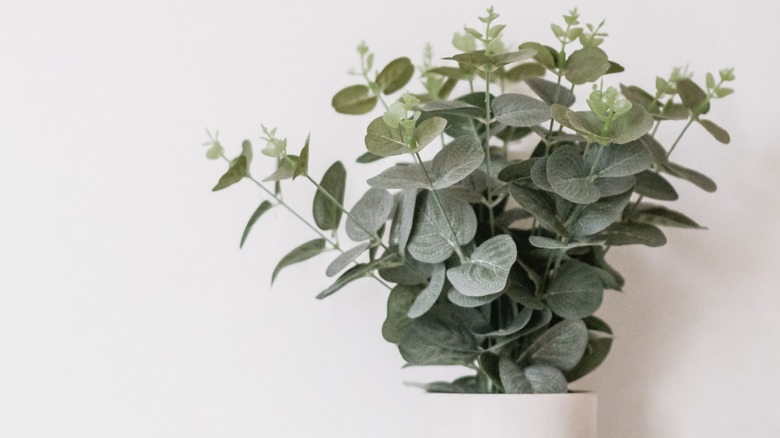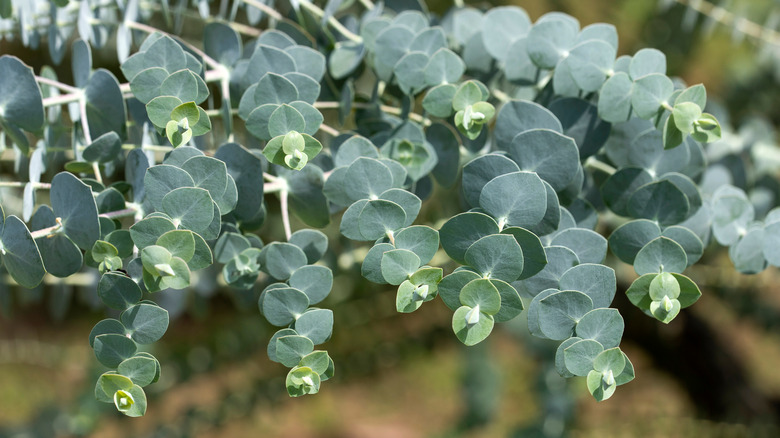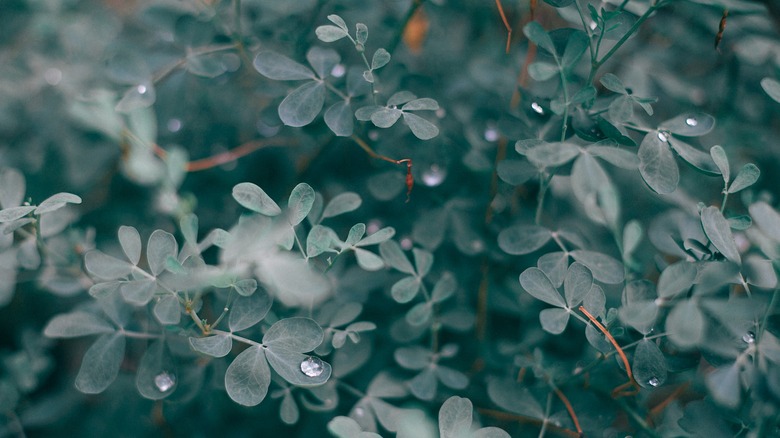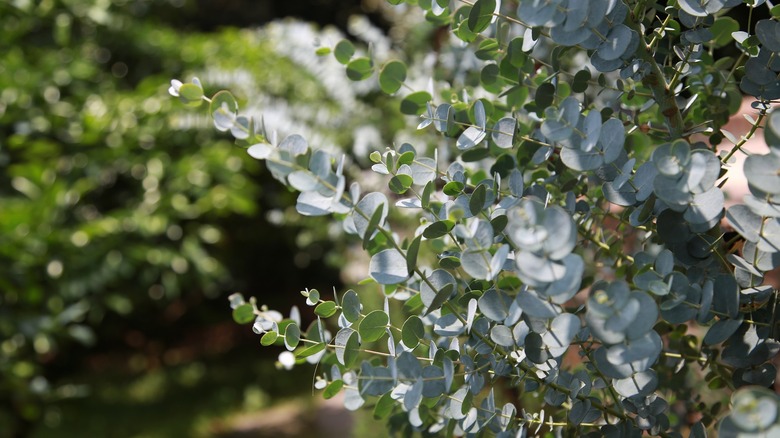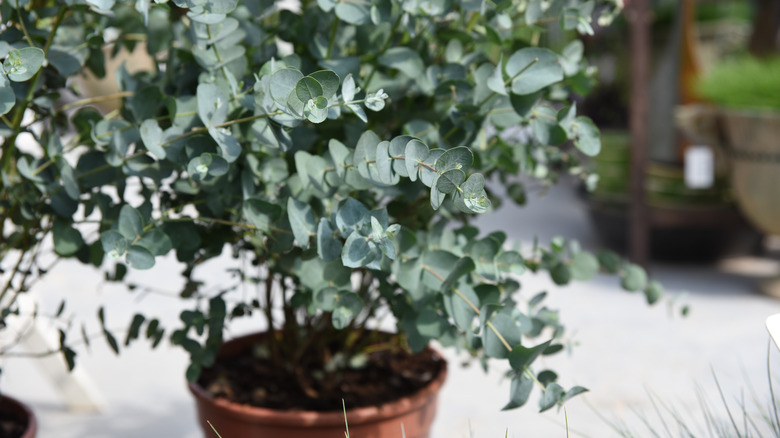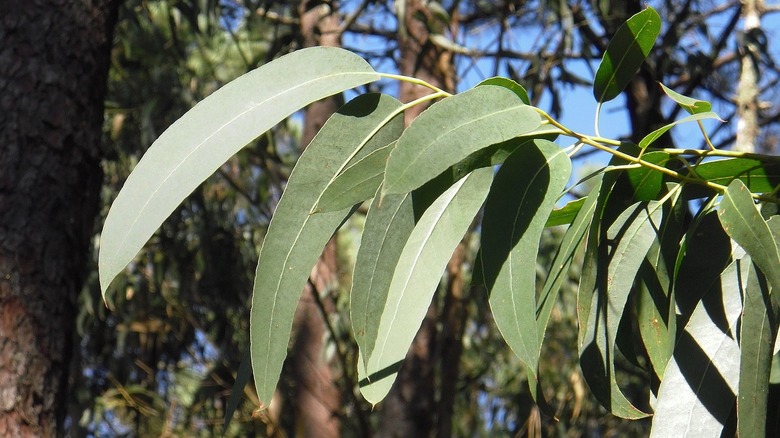How To Successfully Grow A Eucalyptus Plant
Eucalyptus is an incredibly popular plant, often found in floral arrangements for some green accents or put in a vase or pot for a zen touch. It is frequently used in its oil form for its various health benefits and robust, pleasing scent. Many also know it as koala's favorite snack! Eucalyptus belongs to the myrtaceae, or myrtle family, and is a genus with over 700 species, according to Masterclass. Native to Australia, Malaysia, and the Philippines, eucalyptus can be found in nature as both trees that can grow up to 300 feet, and shrubs that can grow up to 30 feet. They can be planted in a home garden in the appropriate conditions or potted and maintained either indoors or out.
With its myriad of benefits, eucalyptus is an excellent choice for indoor and outdoor gardens. When their care needs are met, these plants flourish with delicate, quirky florets and reward you with a unique, fresh scent.
How to use eucalyptus in garden
Eucalyptus trees can be a unique, show-stopping way to landscape your yard. Per The Spruce, they can grow in USDA hardiness zones 8 through 11. If you live in these warmer climates, the dramatic height of a eucalyptus tree or the lushness of a shrub will be a highlight in your landscaping plans.
Planting under and around eucalyptus trees, though, can present a challenge. SF Gate warns that eucalyptus trees heavily absorb nutrients from the ground due to their large roots. Other plants also need to be able to survive the shade created by tree canopies. Leaf litter can also smother young plants, or cause issues in mature plants, so ensure you're routinely removing fallen leaves.
For ground cover, consider planting either lesser or greater periwinkle, depending on your hardiness zone. Lavender also survives well in the conditions created under eucalyptus trees and will create a spectacularly fragrant environment. Shrubs that survive well under eucalyptus include St. John's wort, sweet osmanthus, or California wild rose.
How to grow eucalyptus
According to The Spruce, the easiest and most popular ways to grow a eucalyptus plant is from purchased seeds or young nursery plants, due to the fact eucalyptus grown at home rarely flowers and seeds. While it's not necessarily a reliable method, eucalyptus can be successfully propagated and grown if given the proper conditions and care.
Begin by obtaining your cutting from a young plant — two to 12 months old — preferably later in the summer season using clean shears or scissors. It should be at least 5 inches and have at least four leaves. Prepare a potting mix of three parts tree bark compost to one part of perlite, plus a slow-release granular fertilizer which will help nourish the cutting as it roots. Add the mixture to a nursery pot.
Once the mixture and pot are prepared, strip the bottom half of the cutting of its leaves, and dip the cut end in rooting hormone powder. Add the cutting to the soil up to just below the first leaf and water until the excess drains out of the bottom. Keep in bright, indirect light and at a steady 70 degrees or so. Keep moist, and roots should begin to show in a month. Bring outside once the weather warms back up to stimulate further growth.
How to care for eucalyptus
Indoors or outdoors, eucalyptus plants have the same maintenance needs. The difference is in how to achieve those needs. According to Masterclass, eucalyptus plants need eight to 10 hours of bright, direct full sun. Outside, this is just a matter of correct planting placement or relocating a potted outdoor eucalyptus to an optimal location. Indoors, place your eucalyptus by a south-facing window with plenty of light exposure.
Eucalyptus plants need regular watering but shouldn't become waterlogged. Whether planted in a pot or in the ground, make sure the soil is well-draining. Outdoor plants will benefit from a layer of mulch for regulated moisture retention. Outdoor eucalyptus does not need fertilizing unless you suspect the plant is lacking in nutrients. Indoor houseplants will enjoy bimonthly liquid fertilizer in the spring.
Last, keep eucalyptus plants healthy by pruning both indoor and outdoor plants. This will help maintain a pleasing visual and keep it healthy by removing old or rotten leaves. Use clean pruning shears to regularly remove old, dead, rotten, or leggy stems.
How to repot eucalyptus
Keeping a potted eucalyptus is a great way to reap the benefits of the plant outdoors in incompatible climates or year-round indoors. Pruning can keep the plant from growing too top-heavy, but SF Gate recommends repotting every two or three years in the spring for consistently healthy growth. Younger plants will benefit from being repotted a size up — 2 inches or so — to give roots more room to grow. Older, established plants will just need a fresh pot of soil.
To repot eucalyptus, begin by removing it from its current pot. Gently break up the clumps of roots and remove as much old soil as possible. Prepare the new pot by adding a layer of well-draining, porous potting mix. Consider adding a slow-release, granular fertilizer, or plan on regular fertilizing in the spring. Also, consider adding organic matter, like compost, to help provide the plant with additional nutrients.
Add the plant to the pot, making sure it's sitting relatively at the same depth level as it was previously. Fill with soil to the top, and water thoroughly.
Eucalyptus varieties
Eucalyptus is a genus with over 700 varieties, according to Masterclass. There is plenty of nuance within these varieties, such as bark type and leaf pattern, but they can roughly be broken down into mallet eucalyptus, eucalyptus marlock, eucalyptus mallee, and decorative eucalyptus. Per Home Stratosphere, mallet eucalypti have one single trunk with steeply angled branches that have open space between the branches. Marlock, on the other hand, has densely packed branches with leaves that can reach the ground. Eucalyptus mallee is the shrub variety, and decorative eucalyptus is the variety most commonly seen in floral arrangements.
Here are some subgenus of eucalyptus and a little about each. Eucalyptus pulverulenta, also known as silver-leaved mountain gum, is the most common decorative variety of eucalyptus. Eucalyptus erythronema, the red-flowered mallee, is a shrub eucalyptus identifiable by its red flowers. Eucalyptus eremophila is also known as the sand mallet and is a hardy mallet subgenus with spindly cream-colored flowers. Eucalyptus cladocalyx is commonly known as sugar gum and is a mallet subgenus that is distinguished by its flat leaves and tall heights. Eucalyptus conferruminata is a marlock variety known as the Bald Island marlock or bushy yate and produces long, waxy, tubular flowers.
Is eucalyptus toxic?
Eucalyptus is a popular choice for holistic healing for many. According to Healthline, these plants have a variety of medical benefits and can be consumed in many ways, making them non-toxic to humans, though hard to digest if eaten normally. The leaves are often made into tea, and eucalyptus essential oil is popular for topical application or diffused into the air. When used correctly, these plants can have benefits such as alleviating cold symptoms, treating dry skin, diminishing pain, stimulating relaxation, and as a natural insect repellent.
While these plants have multiple benefits for humans and are a favorite amongst koalas, they are unsafe for cats and dogs. Wag says eucalyptus contains a chemical called eucalyptol, which, when consumed by dogs, behaves as a neurotoxin and gastrointestinal irritant. Symptoms of eucalyptol poisoning include vomiting, diarrhea, excessive drooling, lethargy and depression, confusion, shallow breathing, and seizures. Similar symptoms will be present in cats that consume eucalyptus, warns Pet Medical Center of Vero Beach, and can even start affecting major vital organs if left untreated. Immediately call your vet if you suspect your pet has consumed eucalyptus.
Take care not to diffuse eucalyptus oil around pets, either. Cabbagetown Pet Clinic warns about the adverse reactions pets may experience due to diffusing most oils due to their smaller respiratory systems, which can mimic immediate exposure symptoms. Often, though, this exposure will happen over time, making symptoms hard to notice until they've become severe.
